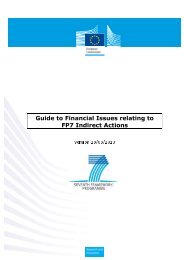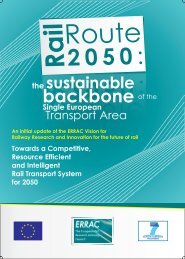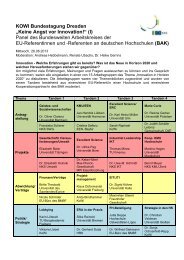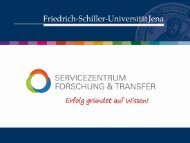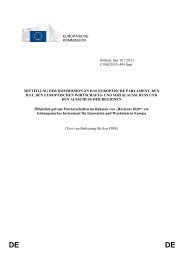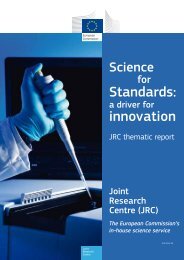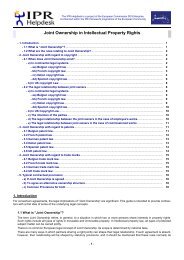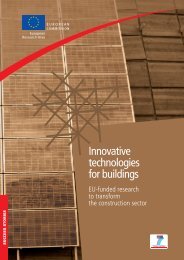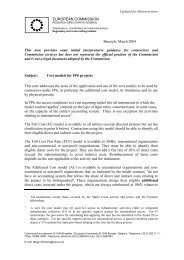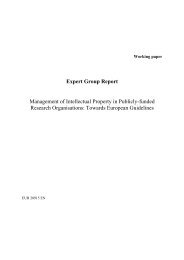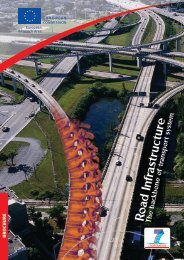Consortium agreement checklist - European Commission
Consortium agreement checklist - European Commission
Consortium agreement checklist - European Commission
You also want an ePaper? Increase the reach of your titles
YUMPU automatically turns print PDFs into web optimized ePapers that Google loves.
This document is a draft for discussion purposes and does not reflect the official or final position of the<br />
<strong>Commission</strong>. It contents is subject to the outcome of the ongoing legislative process concerning the<br />
Framework Programmes and related the Rules of Participation<br />
Document Reference: MS/AS 2002/09 revised 31/03/2003<br />
Sixth Framework Programme<br />
Checklist for a <strong>Consortium</strong> Agreement<br />
Introduction:<br />
The <strong>Consortium</strong> Agreement (“CA”) is an <strong>agreement</strong> made between participants to indirect actions in the<br />
Sixth Framework Programme (FP6), as defined by the rules adopted by the <strong>European</strong> Parliament and the<br />
Council for the participation of undertakings and for the dissemination of the research results 1 (known as<br />
the Rules for Participation – hereafter the “Rules”). A consortium <strong>agreement</strong> is required for all projects<br />
financed under the Sixth Framework Programme except those exempted from this obligation by the call<br />
for proposals to which they have applied.. The Community is not a party to these <strong>agreement</strong>s and plays<br />
no active role in the choices made by the parties of the clauses they deem appropriate to the nature and<br />
purpose of their collaboration and interests. The <strong>Consortium</strong> Agreement must comply with the Rules and<br />
the EC contract.<br />
This <strong>checklist</strong> is provided to assist contractors in an EC-funded project to identify issues that may arise<br />
during the implementation of a research project and which may be facilitated or governed by means of the<br />
<strong>Consortium</strong> Agreement.<br />
Neither the <strong>Commission</strong> nor any person acting on its behalf may be held responsible for the use made of<br />
information contained in this <strong>checklist</strong>, which is provided for general information only. The <strong>checklist</strong> and<br />
its contents are not intended to replace consultation of legal sources or the necessary advice of a legal<br />
expert, where appropriate.<br />
General background to FP6 Rules for Participation:<br />
“<strong>Consortium</strong>” is defined by the Rules and the EC model contract for the implementation of FP6 (the<br />
“Contract”). According to the Rules it means “all the ‘participants’ in the same ‘indirect action’ 2 and<br />
according to the Contract “all the contractors participating in the project covered by this contract”.<br />
”<strong>Consortium</strong> <strong>agreement</strong>” is also defined in both the Rules and the Contract. According to the Rules, it<br />
means “an <strong>agreement</strong> that participants in an indirect action conclude amongst themselves for its<br />
implementation. Such an <strong>agreement</strong> shall not affect participants’ obligations to the Community and to one<br />
another arising out of the Regulation and the Contract.” 3 According to the Contract “an <strong>agreement</strong> that<br />
contractors conclude amongst themselves for the implementation of this contract. Such an <strong>agreement</strong><br />
shall not affect the contractors’ obligations to the Community and/or to one another arising from this<br />
contract.”<br />
The conclusion of a ‘consortium <strong>agreement</strong>’ (“CA”) is mandatory, unless otherwise specified in the<br />
call for proposals 4 . The EC contract will also indicate whether the project is required to have a consortium<br />
<strong>agreement</strong>. Under FP6, participants have greater autonomy to manage the project and to regulate<br />
1 Regulation (EC) N° 2321/2002 of the <strong>European</strong> Parliament and of the Council of 16 December 2002 concerning the rules for the<br />
participation of undertakings, research centres and universities in, and for the implementation of the <strong>European</strong> Community Sixth<br />
Framework Programme (2002-2006) or Regulation N° 2322/2002of the Council concerning the participation of undertakings for the<br />
implementation of the <strong>European</strong> Atomic Energy Community (Euratom) framework programme (2002-2006).<br />
2 Article 2(9) of the Rules.<br />
3 Article 2(6) of the Rules.<br />
4 Article 12(5) of the Rules.<br />
fp6 consortium <strong>agreement</strong> <strong>checklist</strong><br />
1
This document is a draft for discussion purposes and does not reflect the official or final position of the<br />
<strong>Commission</strong>. It contents is subject to the outcome of the ongoing legislative process concerning the<br />
Framework Programmes and related the Rules of Participation<br />
amongst themselves a number of issues relating to its management and operation, as well as issues<br />
relating to intellectual property. This is one of the reasons why the consortium <strong>agreement</strong> is mandatory,<br />
except in those cases where specifically excluded by the call for proposals.<br />
The Rules require the <strong>Commission</strong> to publish non-binding guidelines on points that may be addressed by<br />
the CA, such as:<br />
‣ the internal organisation and management of the consortium;<br />
‣ intellectual property arrangements;<br />
‣ settlement of internal disputes, pertaining to the CA.<br />
The provisions in the Rules that should be addressed include:<br />
a) Provisions for ensuring the technical implementation of the project: ‘The consortium shall implement<br />
the indirect action and shall take all necessary and reasonable measures to that end’ 5 . This means<br />
that the management structure and composition (steering groups, technical groups, etc.) should be<br />
established by the consortium to ensure efficient and effective management of the operational, technical<br />
and financial aspects of the project;<br />
b) ‘Collective responsibility’ is applicable to most actions except SME specific actions, certain specific<br />
support actions and actions to promote and develop human resources and mobility. This responsibility<br />
can be divided into two aspect, the technical and the financial. Technical implementation of the action<br />
shall be the collective responsibility of the participants. (See also Article II.17 of Annex II to the<br />
Contract). Collective financial responsibility (See also Article II.18 of Annex II to the Contract) requires<br />
that “Each participant shall also be liable for the use of the Community financial contribution in proportion<br />
of his share of the project up to a maximum of the total payments he has received. 6 Therefore, the<br />
consortium <strong>agreement</strong> could cover potential solutions to problems relating to technical implementation<br />
(i.e. what to do if one partner does not perform) and, for those contracts in which financial collective<br />
responsibility is imposed, solutions to potential financial problems;<br />
c) The EU contribution is to be paid to the co-ordinator “designated by the ‘consortium’” and identified<br />
in the Contract, who administers the Community financial contribution according to decisions taken by<br />
the ‘consortium’ regarding its allocation to ‘participants’ and activities. Therefore, decisions on how,<br />
when and where the financial contribution will be made as well as to whom, must be addressed by the<br />
consortium itself.<br />
d) A single legal entity can participate in the contract 7 , acting as a sole contractor when it is composed of<br />
the minimum number of eligible participants as required by the Rules). In this particular case, the single<br />
legal entity will have to identify its own conditions by means of its statutes or other internal rules. A<br />
consortium <strong>agreement</strong> per se is not necessary since it is a single contractor (but an <strong>agreement</strong> between<br />
the members of such an entity could be the basis for its statutes or articles of association).<br />
e) “Changes in ‘consortium’ membership”, including its modification or extension to include further<br />
legal entities contributing to the implementation of the project (where applicable 8 through competitive calls<br />
launched, published and evaluated by the ‘consortium’ itself). A participant’s withdrawal shall not affect<br />
access rights under the Contract and the ‘consortium’ must notify any change of its membership to the<br />
5 Article 13(1) of the Rules.<br />
6 Article 13(2) of the Rules,<br />
7 Article 1(2) of the Rules<br />
8<br />
Limited to integrated projects and networks of excellence, where identified in the technical annex to the contract<br />
fp6 consortium <strong>agreement</strong> <strong>checklist</strong><br />
2
This document is a draft for discussion purposes and does not reflect the official or final position of the<br />
<strong>Commission</strong>. It contents is subject to the outcome of the ongoing legislative process concerning the<br />
Framework Programmes and related the Rules of Participation<br />
<strong>Commission</strong>, which may object within 6 weeks of the notification 9 . Terms and conditions for changing and<br />
internal procedures for doing so, in line with the Contract’s provisions, must be clarified.<br />
f) Setting out a plan for the ‘use’ or ‘dissemination’ of knowledge submitted by the contractors 10 .<br />
This may include:<br />
- allocation and exercise of joint ownership; 11<br />
- setting out the terms of ‘use’ in a detailed and verifiable manner, who will exploit what, when<br />
and how and any potential access rights which may be necessary;<br />
- granting additional or more favourable access rights, including access rights to third<br />
parties 12 , or specifying the requirements applicable to access rights, but not restricting the<br />
latter [such <strong>agreement</strong> shall comply with the competition rules]. This could identify preferences,<br />
potential limits, and potential access rights, which may be necessary.<br />
g) Other issues relating to the intellectual property rights either generated during the project or existing<br />
prior to or acquired in parallel with the project:<br />
- Exclusion of specific pre-existing know-how from the obligation to grant access rights<br />
(this must be done by means of a written <strong>agreement</strong> [“collaboration <strong>agreement</strong>”] between the<br />
participants before the contractor concerned signs the Contract). Provisions for identifying<br />
alternative sources of such pre-existing know-how, what to do if essential pre-existed know-how<br />
is excluded, what and how to deal with newcontractors entering the consortium and sideground<br />
13 ) (Article II.35.1d of Annex II to the Contract).<br />
- Granting of sub-licenses (these are subject to the <strong>agreement</strong> of the participant owning the<br />
licensed rights)<br />
- Royalty-bearing access rights on the results or background 14<br />
- Extending the period within which access rights are to be granted to each other after the<br />
end of the project.<br />
Each and every one of these topics should be carefully considered by the participants and, where<br />
appropriate, dealt with in a precise and detailed manner in the consortium <strong>agreement</strong>.<br />
FP CONSORTIUM CHECKLIST - Outline of Contents<br />
- General Information (Identify each party to the <strong>agreement</strong> – Contractor(s) to the EC contract).<br />
- Preamble (Subject of the <strong>Consortium</strong> Agreement) including definitions based on the contract, Rules<br />
and any additional definitions as needed by the consortium).<br />
- Subject of the contract (Title of project).<br />
9 Article 15 of the Rules, Article 10 of the Contract<br />
10<br />
Article 23(1) of the Rules<br />
11 Article 21.3 of the Rules indicates that where several ‘participants’ have jointly carried out work generating knowledge, they shall<br />
have joint ownership of such knowledge and shall agree among themselves on the allocation and the terms of exercising the<br />
ownership of the knowledge with the exception of SMEs.<br />
12 The provisions of Article II.35.1.b of the Contract should be taken into account in such cases.<br />
13<br />
IPR acquired during the life of the project but not related to the contract<br />
14<br />
Access rights to the results of the action shall be granted to the participants in the action on a need-to-use, royalty-free basis,<br />
unless other conditions were agreed before the signature of the contract and access to background shall be granted on fair and nondiscriminatory<br />
conditions to be agreed, Annex II.35.3a<br />
fp6 consortium <strong>agreement</strong> <strong>checklist</strong><br />
3
This document is a draft for discussion purposes and does not reflect the official or final position of the<br />
<strong>Commission</strong>. It contents is subject to the outcome of the ongoing legislative process concerning the<br />
Framework Programmes and related the Rules of Participation<br />
- Technical provisions<br />
Technical contribution of each party (as set out in Annex I to the EC contract);<br />
Technical resources made available;<br />
Production schedule for inter-related tasks and for planning purposes<br />
Expected contribution, maximum effort expected<br />
Modification procedure;<br />
Provisions for dealing with non-performing contractor(s).<br />
- Commercial provisions<br />
Confidentiality;<br />
Ownership of results / joint ownership of results / difficult cases (i.e. pre-existing know-how that is very<br />
closely linked to the result, making it difficult to distinguish the pre-existing know-how from the result);<br />
Legal protection of results (patent rights);<br />
Commercial exploitation of results and any necessary access rights;<br />
Commercial obligations;<br />
Relevant patents, know-how, and information;<br />
Sub-licensing;<br />
Pre-existing know-how excluded from use in the project.<br />
- Organisational provisions<br />
Committees – establishment, composition, procedures, role and nature:<br />
Steering, management, technical, IPR, financial etc;<br />
Co-ordination of committees;<br />
Amendment / revision of the <strong>agreement</strong>.<br />
- Financial provisions<br />
Financing plan;<br />
Modification procedure;<br />
Mutual payments, common costs;<br />
Distribution of management costs;<br />
Auditing of costs:<br />
Audit certificates;<br />
How to deal with financial collective responsibility;<br />
Provisions for dealing with non-performing contractor(s);<br />
Third party resources - identifying parties and resources.<br />
- Legal provisions<br />
Legal form of the co-operation;<br />
Duration of the <strong>agreement</strong> versus duration of the EC contract (i.e. 6 months one year longer, etc)<br />
Penalties for non-compliance with obligations under the <strong>agreement</strong>;<br />
Applicable law and the settlement of disputes;<br />
Secondment of personnel;<br />
What to do if all the contractors do not sign the EC contract.<br />
FP CONSORTIUM CHECKLIST IN DETAIL<br />
General Information<br />
In addition to the traditional clauses included to identify the parties, it is desirable to include, if possible,<br />
an exhaustive list of the persons likely to work on the contract. This allows for insistence on confidentiality<br />
4<br />
fp6 consortium <strong>agreement</strong> <strong>checklist</strong>
This document is a draft for discussion purposes and does not reflect the official or final position of the<br />
<strong>Commission</strong>. It contents is subject to the outcome of the ongoing legislative process concerning the<br />
Framework Programmes and related the Rules of Participation<br />
for the results of the collaboration. In very large projects, at least the key players should be identified.<br />
This clause complements and reinforces the confidentiality clauses.<br />
The contribution of any sponsor should be mentioned, as well as any third party providing resources to a<br />
contractor participating in the project. (They are not parties to the consortium <strong>agreement</strong> or to the EC<br />
Contract but their contribution or interest should be mentioned if appropriate.)<br />
Preamble<br />
The preamble summarises the context of the <strong>agreement</strong> and should include the title and acronym of the<br />
project and specific RTD programme:<br />
- the strategic reasons for the partners' co-operation, with a possible summary of negotiations;<br />
- reasons why the parties are applying a specific legal framework;<br />
- language(s) used in drafting the <strong>agreement</strong> and language version considered to be valid in the event of<br />
multiple translations;<br />
- definition of terms used in the <strong>agreement</strong>: commercial, technical, financial, legal. For the sake of clarity,<br />
words mentioned in the <strong>Consortium</strong> Agreement used should have the same definition and meaning as<br />
that contained in the EC Contract with the <strong>European</strong> <strong>Commission</strong>, including its Annexes, or in the Rules.<br />
Additional definitions may be included as necessary for the consortium. .<br />
Subject of the Agreement<br />
The subject of the <strong>agreement</strong> must be described very precisely as it influences many clauses in the<br />
contract and may include a guarantee incurring the liability of the parties, which could turn out to be<br />
costly.<br />
It is necessary to stipulate as precisely as possible:<br />
preliminary technical specifications;<br />
and/or the desired technical results;<br />
and/or the work to be accomplished; duration of the <strong>agreement</strong> – beginning and end and any provisions<br />
which extend beyond the end of the <strong>agreement</strong>.<br />
In order to limit the volume of this section, it may be judicious to include the majority of the technical<br />
descriptions in appendices to the <strong>agreement</strong> and preserve only the basic information in the body of the<br />
<strong>agreement</strong>.<br />
If desired a copy of the EC Contract can be appended to the CA.<br />
Technical Provisions<br />
a. Technical contribution of each party:<br />
- as precise a definition as possible of the tasks that each party intends to carry out (possibly referring to<br />
appended technical documents);<br />
- relationships between the tasks of the different participants and any inter-dependence.<br />
fp6 consortium <strong>agreement</strong> <strong>checklist</strong><br />
5
This document is a draft for discussion purposes and does not reflect the official or final position of the<br />
<strong>Commission</strong>. It contents is subject to the outcome of the ongoing legislative process concerning the<br />
Framework Programmes and related the Rules of Participation<br />
b. Technical resources made available:<br />
- human resources;<br />
- equipment and facilities;<br />
- information, whether protected or not.<br />
These means should be as detailed as possible:<br />
- number of persons;<br />
- qualifications;<br />
- nature of the equipment used;<br />
- type of information disclosed: plans, manuals, calculations, prototypes, etc., delivery dates, place at<br />
which it is made available, language used.<br />
c. Production schedule, for information:<br />
Out of prudence, the parties should not establish irrevocable schedules unless they are absolutely sure<br />
that these can be met. It is much better to include contingency plans for delays or missed deadlines.<br />
An irrevocably accepted production schedule can be considered to be a guaranteed commitment and<br />
may involve payment of indemnities if not met.<br />
There are other methods to guarantee minimum compliance with deadlines, as discussed in the section<br />
on Organisational Provisions.<br />
d. Maximum efforts:<br />
In view of the nature of the work to be carried out, it may be useful to specify that the commitment of the<br />
participants applies to the availability of human, material and intellectual resources and making best<br />
efforts to ensure that the results of the project are obtained rather than the actual achievement of the<br />
desired results.<br />
It may be advisable to fix a financial ceiling for the outlays that each participant is ready to make.<br />
e. Modification procedures:<br />
The technical provisions give an overview of the co-operation at any given time. The information provided<br />
may have to be adjusted or even be discarded altogether as the work progresses, depending on the<br />
outcome. To deal with highly volatile situations, it is advisable to provide a very flexible procedure for<br />
making changes to the initial specifications. This could go as far as including the termination of certain<br />
tasks, the withdrawal of certain parties, the inclusion of new partners, etc.<br />
To avoid disputes, the conditions for this procedure should be clearly indicated. (see Organisational<br />
Provisions).<br />
Rules for dissemination and use<br />
In addition to the basic confidentiality clause, the provisions on use and dissemination mainly specify the<br />
allocation of ownership and exploitation rights on the results of the co-operation, whether initially<br />
expected or not and any particular provisions regarding access rights.<br />
fp6 consortium <strong>agreement</strong> <strong>checklist</strong><br />
6
This document is a draft for discussion purposes and does not reflect the official or final position of the<br />
<strong>Commission</strong>. It contents is subject to the outcome of the ongoing legislative process concerning the<br />
Framework Programmes and related the Rules of Participation<br />
The basic principle applied in drafting these provisions is to stress the capacities and role played by each<br />
party in order to encourage maximum use of the results either by means of commercial exploitation or by<br />
further research applications.<br />
a. Confidentiality:<br />
The confidentiality clause should cover the following points:<br />
a) An undertaking as to confidentiality concerning the information disclosed by the other parties as part of<br />
the operation and identified as confidential. In most cases, the scope of this undertaking is very wide and<br />
subject to few expressly mentioned restrictions (sales literature and relations with any sub-contractors).<br />
Particular provisions regarding marking of information and procedures for making such information<br />
available can be introduced.<br />
b) Limits on the undertaking in respect of information not considered to be confidential because:<br />
- the content of any of the document, information or material becomes publicly available through work or<br />
actions lawfully performed outside this contract and not based on activities under it; or<br />
- the content of the document, information or material has been communicated without confidentiality<br />
restrictions or these are subsequently waived; or<br />
- the information is lawfully received from a third party who is in lawful possession thereof and under no<br />
obligation of confidence to the disclosing party.<br />
c) The period during which this undertaking must be respected. Generally, this period exceeds the EC<br />
Contract's duration or the consortium <strong>agreement</strong>’s expiry date (e.g. a 10-year term). Frequently, it equals<br />
or exceeds the patent protection period.<br />
b. Ownership of results:<br />
The joint ownership of knowledge should be avoided where possible. Where it is not possible to<br />
distinguish the contribution of two or more participants or the result cannot be separated into distinctive<br />
parts, joint ownership will be necessary. In cases of joint ownership, the participants concerned must<br />
conclude a specific <strong>agreement</strong>, as to the allocation between themselves of the ownership rights and the<br />
terms of exercising such ownership in accordance with the provisions of the Contract. Issues that can be<br />
determined by the joint owners with respect to sharing of ownership include:<br />
- territorial division, by virtue of which one party to the invention owns the discovery only in some<br />
countries and the other parties are free to register it in other specified countries;<br />
- division of markets, by virtue of which one party to the invention owns the discovery only in business<br />
sectors in which it is already active;<br />
- licensing of results for the other parties, within specified limits.<br />
In the event of an invention being the work of a single party to the Contract and solely the result of its<br />
intrinsic skills rather than shared knowledge, this party will be the exclusive owner of the results, subject<br />
to granting access rights to the other participants where necessary for their execution of the project or the<br />
utilisation of their own results. Conditions for such granting of rights, such as scope, limitations and<br />
remuneration, if applicable, should be included in the consortium <strong>agreement</strong> in as much detail as<br />
possible.<br />
fp6 consortium <strong>agreement</strong> <strong>checklist</strong><br />
7
This document is a draft for discussion purposes and does not reflect the official or final position of the<br />
<strong>Commission</strong>. It contents is subject to the outcome of the ongoing legislative process concerning the<br />
Framework Programmes and related the Rules of Participation<br />
c. Legal protection of results (patent rights):<br />
It may be useful to stipulate an option clause in the event that the designated owner of the result waives<br />
its option to start registration proceedings within the period stipulated in the Contract.<br />
d. Commercial exploitation of results:<br />
The results of EC-funded projects are generally owned by the contractor generating them. However, the<br />
nature of the work carried out may result in joint ownership of results. In this case, the parties must<br />
determine the terms and conditions for ownership and exploitation. In such cases, use by means of<br />
commercial exploitation may be subject to restrictions aimed at optimising effectiveness by focusing the<br />
parties’ exploitation to that of their main area of speciality:<br />
- territorial division between the participants;<br />
- division of applications markets.<br />
It is necessary to take care in drafting these clauses, to ensure that they do not conflict with the principle<br />
of free trade of goods and competition rules within the EC.<br />
If the result is owned by a single party, that party is free to use it as it sees fit (within the requirements of<br />
the EC contract). However, where appropriate, parties to the consortium <strong>agreement</strong> may agree tocertain<br />
restrictions such as:<br />
- territorial division;<br />
- division of markets;<br />
- licences for the other participants, which are then free to use the same results within specified limits.<br />
If the participants likely to jointly own and use the results have very similar arrangements, capable of<br />
turning them into competitors during the commercial exploitation phase, it is advisable to settle this<br />
potential for conflict when signing the <strong>agreement</strong>. For example, by stipulating that a joint production and<br />
marketing structure (Economic Interest Grouping or joint venture) be created to use the results of the cooperation.<br />
In this case, the rules governing the organisation of such a structure must be specified.<br />
e. Obligation to use:<br />
The EC Model Contract, requires that the results of the project be used (commercial exploitation or further<br />
research applications) and that the plan for use and dissemination be clearly identified in the activity<br />
reports. It also requires that where dissemination would not adversely affect use, the participants must<br />
disseminate the results within two years of the end of the project.<br />
f. Dissemination of knowledge:<br />
The process of dissemination of results is the responsibility of the owner and must respect the IPR<br />
provisions in the EC Model Contract (Annex II Part C). However, dissemination cannot start until either<br />
the knowledge is protected or there is an assurance that dissemination will not affect the protection of the<br />
results.<br />
[In case of dissemination (e.g. a conference), the written <strong>agreement</strong> of the owner(s) is mandatory.]<br />
According to the EC Model Contract (Article II.34.2 of Annex II), the participants must disseminate their<br />
knowledge within a period of 2 years after the end of the project where such dissemination would not<br />
adversely affect use. Therefore, the use and dissemination plan must clearly cover that period continuing<br />
fp6 consortium <strong>agreement</strong> <strong>checklist</strong><br />
8
This document is a draft for discussion purposes and does not reflect the official or final position of the<br />
<strong>Commission</strong>. It contents is subject to the outcome of the ongoing legislative process concerning the<br />
Framework Programmes and related the Rules of Participation<br />
after the end of the project. The consortium <strong>agreement</strong> should make provisions for dealing with this in<br />
cases where the consortium’s management structure will have ended by this time.<br />
g. Publication<br />
According to the EC Model Contract (Article II.33.3 of Annex II), a participant shall give prior notice of any<br />
planned publication of its knowledge to the EC and the other participants. This participant shall<br />
communicate a copy of the data, if the EC or the other participants so request, within 30 days after receipt<br />
of such notice. The EC and the other participants may object to the publication within a new period of 30<br />
days after receipt of the envisaged data to be published. If the objection is confirmed, the publication is<br />
postponed until all requirements regarding protection and confidentiality have been fulfilled.<br />
h. Background Patents, know-how and information<br />
The implementation of a research or innovation project may require the use of pre-existing know-how,<br />
owned by one of the parties, resulting from work carried out prior to, or independently of, the <strong>agreement</strong>.<br />
In this case, the EC Model Contract provides that the party owning the knowledge must disclose it to the<br />
other participants, unless specifically excluded by means of a written <strong>agreement</strong> before the signature of<br />
the Contract. It is important that any pre-existing know-how that is to be excluded from access during the<br />
life of the project be identified in the consortium <strong>agreement</strong>, or in any other <strong>agreement</strong> between the<br />
parties involved. The participants can include conditions or limitations on such access so that the<br />
recipient may only use it to carry out their obligations under the EC Contract. Any such restrictions or<br />
conditions should be reflected in the <strong>agreement</strong>.<br />
It is important to distinguish pre-existing know-how held prior to the conclusion of the EC contract<br />
from that acquired in parallel with it (side-ground).<br />
In the event that the project produces results, partly based on the patents or know-how owned by one of<br />
the parties prior to the <strong>agreement</strong>, which have not been excluded by prior <strong>agreement</strong>, the EC contract<br />
provides that access rights to the pre-existing know-how are to be provided on a royalty-free basis for the<br />
execution of the project and on a fair and non-discriminatory basis for the use of the contractor’s own<br />
knowledge.<br />
It is always useful to cover the eventuality of the owner refusing to disclose or licence its knowledge if the<br />
disclosure of such information is likely to do serious damage to its own business and how to deal with<br />
exclusion of necessary pre-existing know-how.<br />
i. Sub-licences:<br />
Generally speaking access rights are granted without the right to sub-licence. However, the licensor can<br />
authorise the licensee to grant sub-licences to third parties within clearly defined limits. In this case, it is<br />
necessary to indicate:<br />
- [special clause for sublicensing of data]<br />
- the conditions under which such sublicenses are granted;<br />
- the need to obtain the licensor's prior consent in accordance with duly explained grounds.<br />
- the need to maintain any access rights as required under the EC contract.<br />
fp6 consortium <strong>agreement</strong> <strong>checklist</strong><br />
9
This document is a draft for discussion purposes and does not reflect the official or final position of the<br />
<strong>Commission</strong>. It contents is subject to the outcome of the ongoing legislative process concerning the<br />
Framework Programmes and related the Rules of Participation<br />
Organisational Provisions<br />
a. Committees:<br />
• Steering and co-ordination committee<br />
The creation of a co-ordination structure for the partners is desirable as soon as possible. This<br />
structure may have different names (steering committee, liaison committee, management committee,<br />
and can be broken down into different sub-groups such as financial, technical, legal, etc), but its role<br />
is always the same, namely:<br />
- to define, divide and develop the tasks;<br />
- to check the progress of the work;<br />
- to co-ordinate the research teams;<br />
- to co-ordinate the preparation of the reports (technical, financial, etc.);<br />
- to advise and direct the partners on the developments necessary for the project;<br />
- to permit formal exchanges of information between the partners.<br />
The <strong>agreement</strong> should carefully define:<br />
- the committee’s exact delegated responsibilities;<br />
- its organisational conditions (composition, etc.);<br />
- its operating conditions (meetings, decisions, chairmanship, etc.);<br />
- the scope of its power.<br />
The work of this steering committee is frequently translated into daily management and<br />
representation duties by a co-ordinator (or manager) selected from among the parties.<br />
Here too, the <strong>agreement</strong> should clearly define its’ responsibilities and powers.<br />
• Other committees can be created as necessary and should report to the steering or co-ordination<br />
committee. Provision should be made for the creation of ad hoc committees as and when necessary.<br />
b. Co-operation supervision:<br />
Each party undertakes to follow the production schedule and budget specified in the technical provisions<br />
of the contract. In view of the uncertain character of many projects, these production timetables are<br />
generally given for information only and do not incur liability for the parties.<br />
However, the risk of uncontrolled time and cost escalation is very real in many projects. To limit this risk, it<br />
is desirable to provide for a strict and effective inspection and supervision system (possibly via input from<br />
scientific or technical committees) managed by the steering committee, and including:<br />
- frequent progress meetings (ranging from once a month to once per quarter);<br />
- frequent technical and financial progress reports (actions completed and results obtained);<br />
- optional exceptional meetings as soon as agreed estimated deadlines are overrun, including the right for<br />
the parties to review their position within the co-operative venture based on clearly stated reasons.<br />
c. Revision of the <strong>agreement</strong>:<br />
In order to avoid disputes, the consortium <strong>agreement</strong> should provide simple and clear procedures for its<br />
revision:<br />
- modification of technical provisions;<br />
fp6 consortium <strong>agreement</strong> <strong>checklist</strong><br />
10
This document is a draft for discussion purposes and does not reflect the official or final position of the<br />
<strong>Commission</strong>. It contents is subject to the outcome of the ongoing legislative process concerning the<br />
Framework Programmes and related the Rules of Participation<br />
- modification of financial provisions;<br />
- withdrawal of partners;<br />
- acceptance of new partners;<br />
- termination of the <strong>agreement</strong> after full completion of the programme;<br />
- termination prior to full completion or upon early termination of the EC contract.<br />
Decision-making conditions should be mentioned:<br />
- routine steering committee meetings;<br />
- calling of exceptional meetings;<br />
- powers of each party;<br />
- decision-making method (unanimously, majority <strong>agreement</strong>, etc.).<br />
Financial Provisions<br />
a. Financing plan:<br />
- Detailed estimate of the total cost;<br />
- financial contribution of each party and EC contribution to some;<br />
- outside financial assistance (from authorities, banks, venture capital, etc.);<br />
- expenses and financing plan;<br />
- annual budget.<br />
Detailed documents may be referred to in appendices in order to keep the body of the <strong>agreement</strong> light.<br />
b. Modification procedures<br />
The data in the financing plan is generally for information only and may undergo changes.<br />
In order to account for this changeable nature, the <strong>agreement</strong> should clearly specify the conditions<br />
governing any financial modifications and their consequences on the organisation of the co-operation<br />
(see Organisational Provisions).<br />
c. Mutual payments:<br />
Under certain circumstances, several parties may incur common expenses (personnel, equipment, etc.).<br />
It is desirable to provide for the procedure governing the payment of this type of expense by each party in<br />
the <strong>agreement</strong> and to clearly identify its reporting to the <strong>Commission</strong> for Community contribution to those<br />
costs:<br />
- reimbursable advance of a participant and method of reimbursement;<br />
- joint account and conditions of paying in funds;<br />
- terms of payment;<br />
- currency;<br />
- impact of exchange rates and bank transfer costs;<br />
- payment of taxes;<br />
- interest, if any,<br />
- identification of management activity costs beyond that provided by EC contract etc.<br />
d. Selection of Costs to be registered under the management activity heading:<br />
Costs for management of the consortium shall be reimbursed by the <strong>Commission</strong> financial contribution,<br />
up to 100 % of the costs incurred. However, the EC contribution of 100% of management costs is limited<br />
to 7 % of the EC funding.<br />
fp6 consortium <strong>agreement</strong> <strong>checklist</strong><br />
11
This document is a draft for discussion purposes and does not reflect the official or final position of the<br />
<strong>Commission</strong>. It contents is subject to the outcome of the ongoing legislative process concerning the<br />
Framework Programmes and related the Rules of Participation<br />
This limit of 7% may mean that some management costs are not covered entirely by the EC financial<br />
contribution. For this reason the management tasks and the related costs must be detailed and easily<br />
identified in each participant’s accounting system. Reference should be made to the EC model contract<br />
and the related financial guidelines.<br />
The tasks considered as ’technical’ should be clearly identified as such. It must be anticipated that coordination<br />
and management tasks are of a different nature. Beyond the 100% funded 7% management<br />
budget there is no funding for management purposes per se. Certain research coordination activities<br />
linked to technical issues could be implemented in the RTD work packages to benefit from the funding<br />
rates appropriate to those activities.<br />
Legal Provisions<br />
a. Legal co-operation status:<br />
<strong>Consortium</strong> <strong>agreement</strong>s may take different legal forms:<br />
- an <strong>agreement</strong> or contract;<br />
- the establishment of an association;<br />
- an Economic Interest Grouping or <strong>European</strong> Economic Interest Grouping;<br />
- a joint venture.<br />
The advantages and disadvantages of each particular legal structure should be examined and<br />
determined in accordance with the needs of the consortium.<br />
b. Terms of the <strong>agreement</strong>:<br />
It is necessary to specify the following items:<br />
- the effective date of the entry into force of the <strong>agreement</strong>.<br />
- the expiry date of the <strong>agreement</strong>.<br />
- termination of the <strong>agreement</strong>, including the possibility of tacit renewal and extension.<br />
– cancellation, with notice by one of the parties, which should be made particularly easy in order to<br />
preserve the flexibility of the contract (e.g. breakdown of the co-operation into several phases with the<br />
right to free withdrawal at the end of each phase).<br />
- the withdrawal of a participant should not entail the automatic termination of the consortium <strong>agreement</strong>.<br />
- the admission of new partners should be possible without affecting the <strong>agreement</strong> itself (e.g. by means<br />
of an amendment to the consortium <strong>agreement</strong>).<br />
- the revision - even basic - of the technical or financial provisions should not entail the automatic<br />
cancellation of the <strong>agreement</strong>.<br />
- conditions for modifying the consortium <strong>agreement</strong> should be clearly defined (see Organisational<br />
Provisions).<br />
- on the expiry date or when a participant withdraws, or upon termination of the participation of a<br />
participant, the <strong>agreement</strong> may provide for the return of all documents exchanged during the period of cooperation.<br />
- the confidentiality clause may survive the duration of the consortium <strong>agreement</strong> for a specified period<br />
(see provisions of EC model contract).<br />
- the arbitration clause (see d. below) may also survive the duration of the consortium <strong>agreement</strong>.<br />
- certain IPR provisions should also survive the duration of the consortium <strong>agreement</strong> (see provisions of<br />
EC model contract).<br />
fp6 consortium <strong>agreement</strong> <strong>checklist</strong><br />
12
This document is a draft for discussion purposes and does not reflect the official or final position of the<br />
<strong>Commission</strong>. It contents is subject to the outcome of the ongoing legislative process concerning the<br />
Framework Programmes and related the Rules of Participation<br />
c. Penalties for non-compliance with the <strong>agreement</strong>’s obligations:<br />
In the interest of all parties, it is advisable to stipulate such penalties precisely in the <strong>agreement</strong>:<br />
- payment of fixed indemnities (delay in providing information, non-compliance with exclusivity clauses,<br />
etc.);<br />
- financial compensation to offset any damage;<br />
- payment of interest (delay in payments);<br />
- cancellation of the <strong>agreement</strong> in the most serious cases (failure to provide information, failure to pay,<br />
disclosure of any confidential material, etc.), respecting article 15.1- Termination of the Contract by the<br />
Contractors - Annex II- General Conditions-.<br />
d. Applicable law and the settlement of disputes:<br />
The law used to settle disputes is frequently the national law of one of the parties and generally the law<br />
offering the highest degree of technological protection. However, any national law can be applied, even if<br />
it is not directly connected with the contract (e.g. a French-German contract under Swiss jurisdiction).<br />
The <strong>agreement</strong> may also stipulate that the rules of international trade will be applied, which are frequently<br />
closer to the problems encountered than are Member State laws.<br />
It is not in the interests of the parties to reach the stage of court proceedings. This may be damaging<br />
byresulting in:<br />
- a serious deterioration in the relations between the parties,<br />
- wasted time,<br />
- bad publicity.<br />
Most <strong>agreement</strong>s provide a settlement clause under which the parties have recourse to an arbitrator<br />
(normally the International Chamber of Commerce) to settle their disputes and find an <strong>agreement</strong>.<br />
In this case, the <strong>agreement</strong> must stipulate the applicable arbitration procedure and the scope of its<br />
jurisdiction (arbitration site and the way in which recognised experts will intervene).<br />
e. Secondment of personnel:<br />
Many <strong>agreement</strong>s require the participants to second personnel to other organisations, frequently abroad.<br />
In this case, it may be useful to stipulate in the contract the main conditions of such secondment, which<br />
may entail an independent <strong>agreement</strong> separate from the main <strong>agreement</strong>.<br />
The following points might be taken up:<br />
- the work needed to prepare the secondment;<br />
- accommodation;<br />
- interpreters;<br />
- travel allowances;<br />
- working hours;<br />
- remuneration;<br />
- overtime;<br />
- travel expenses;<br />
- holidays;<br />
- medical care and reimbursement of costs;<br />
- other social security items (life insurance, pension funds, etc.);<br />
- settlement of accounts and payment;<br />
- working conditions;<br />
- employer liability;<br />
fp6 consortium <strong>agreement</strong> <strong>checklist</strong><br />
13
This document is a draft for discussion purposes and does not reflect the official or final position of the<br />
<strong>Commission</strong>. It contents is subject to the outcome of the ongoing legislative process concerning the<br />
Framework Programmes and related the Rules of Participation<br />
- insurance;<br />
- applicable law;<br />
- arbitration.<br />
Specific provisions for:<br />
- Integrated Projects<br />
- sub-projects coordination;<br />
- calls for extension by the <strong>Commission</strong> and its implications;<br />
- special calls for extension of the consortium membership;<br />
- annual update of the implementation plan;<br />
- annual update of financial plan (the implementation plan can also identify the pre-existing knowhow<br />
and knowledge to which access rights are needed to achieve the objectives and deliverables<br />
of the project. In the update, the requests for new pre-existing know-how and knowledge should<br />
be listed, including when new participants join in the project);<br />
- annual review and consequences of additional work or revisions;<br />
- annual audit certificates / partner;<br />
- cost sharing;<br />
- how to deal with 7% management activity (costs reimbursed at 100%);<br />
- distribution of the Community financial contribution.<br />
- Networks of Excellence: - measurement of integration;<br />
- sub-projects co-ordination;<br />
- calls for extension by the <strong>Commission</strong> and its implications;<br />
- special calls for extension of the consortium membership;<br />
- annual update of joint programme of activities;<br />
- annual review and consequences of additional work or revisions;<br />
- annual review resulting in further work with no EC contribution during next period (actions to be<br />
taken by the consortium);<br />
- annual audit certificates / partner;<br />
- cost sharing;<br />
- how to deal with 7% management activity (costs reimbursed at 100%);<br />
- distribution of the Community financial contribution and treatment of cases where costs do not<br />
exceed EC contribution.<br />
- Co-operative Research:<br />
SME contractors agree to ensure that, in consideration for the ownership of all knowledge generated<br />
by the project, the RTD Performers will be reimbursed in full for their eligible costs under the project.<br />
Any EC contribution to the other contractors may also be used to this end.<br />
- Collective Research:<br />
Enterprise groupings agree to ensure that, in consideration for the ownership of all knowledge<br />
generated by the project, the RTD Performers will be reimbursed in full for their eligible costs under<br />
the project. Any EC contribution to the other contractors may also be used to this end.<br />
- Integrated Infrastructure Projects (where more than one contractor)<br />
- provisions relating to unit costs<br />
- arrangements with user groups and interaction between different user groups<br />
- additional reporting requirements<br />
fp6 consortium <strong>agreement</strong> <strong>checklist</strong><br />
14



